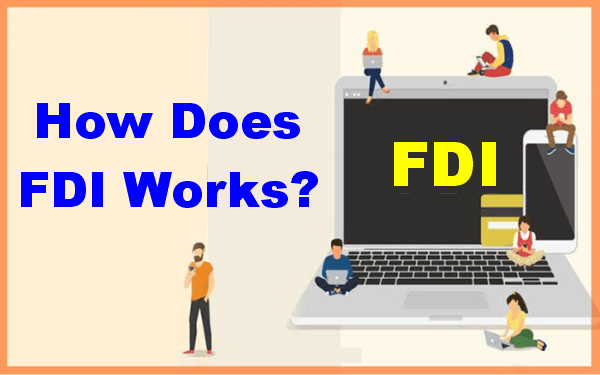Direct Foreign Investment (FDI): What It Is, Types, and ExamplesWhat is a Foreign Direct Investment (FDI)?Foreign direct investment (FDI) is the acquisition of an interest or an ownership stake in a foreign firm or project by a foreign investor, corporation, or government. Typically, the phrase refers to a corporate decision to buy a sizable portion of a foreign company or buy it all together to enlarge services to a new area. The phrase often does not refer to a stock purchase in a single overseas firm. 
The controlling ownership of a commercial company in one country by an entity headquartered in another country is also referred to as a foreign direct investment (FDI), a subset of international factor movements. The notion of "control" distinguishes foreign direct investment from national portfolio investment, a passive expenditure in foreign securities like public stocks and bonds. The Financial Times reports, "Standard control definitions rely on the globally recognized 10 percent minimum agreed threshold of voting shares. However, this is a murky area because control in widely owned corporations frequently results from a smaller block of shares. Power over management, technology, and key inputs may grant de facto control." How does Foreign Direct Investment (FDI) work?
Target businesses or projects in open economies with a trained workforce and above-average development potential for the investor are typically considered by businesses or governments seeking foreign direct investment (FDI). The value of little government regulation is also common. FDI typically involves more than just capital expenditures. It could also entail the supply of administration, technology, and tools. More than $1.8 trillion in foreign direct investments will be made in the upcoming year, indicating the significant net financial sums associated with FDI. In 2021, China, Canada, Brazil, and India were the other leading FDI destinations after the United States. The United States was likewise in first place for FDI outflows, preceded by Germany, Japan, China, and the United Kingdom. The attractiveness of a country as a lengthy investment location may be determined by looking at FDI inflows as a share of GDP (gross domestic product). FDI as a proportion of GDP is frequently substantially greater for smaller, more dynamic economies, such as the Cayman Islands (110%), Hungary (109%), and Hong Kong (34%). Theoretical BackgroundAccording to Grazia Ietto-Gillies, neoclassical economics based on macroeconomic principles addressed the reasons for foreign investment and multinational businesses before Stephen Hymer's thesis about direct investment in the 1960s. These ideas were founded on the traditional theory of commerce, according to which trade was motivated by the disparity in the costs of producing goods in different nations, focusing on the low cost of production as a driver of a firm's international operations. For instance, Joe S. Bain only used three basic factors to address the internationalization challenge: absolute cost advantages, the benefits of product differentiation, and economies of scale. Furthermore, a perfect competition was assumed to exist when neoclassical ideas were developed. Hymer developed a theory that went beyond the present theories to explain why this phenomenon occurred because he believed that the theories previously mentioned could not illustrate foreign investment and its motivating factors. Hymer was intrigued by the reasons behind the large foreign investments made by American corporations. Hymer focused on filling in the gaps related to overseas investment to meet the issues his predecessors faced. The hypothesis put forward by the author looks at foreign investment differently and from a firm-specific perspective. Hymer contends that there is a distinction between mere capital investment, often known as portfolio investment, and direct investment, in contrast to conventional macroeconomics-based investment theories. Hymer continues by criticizing neoclassical ideas and asserting that the notion of capital movements is insufficient to explain global production. Additionally, he clarifies that FDI is focused on specific industries within various nations and is not always include a transfer of cash from a home country to a host country. In contrast, FDI would involve a wide range of industries in fewer nations if interest rates were the primary driving force. Loans taken out in the host nation, payments made in return for equity (patents, technology, machines, etc.), and other strategies can all be used to fund foreign direct investment. The key factors affecting FDI are the country's economic development prospects at the time FDI is made. In response to concerns, Hymer included some more FDI variables while also assuming market inefficiencies. These are listed below:
Hymer's significance in the area of global business and FDI originates from his being the first to postulate about the existence of MNEs and the reasons behind FDI above macroeconomic principles, as well as their effects on succeeding researchers and concepts in global business, such as the OLI thesis by John Dunning and Christos Pitelis, which places a greater emphasis on transaction costs. Furthermore, "the asset and evolutionary theories, two other key academic advances in the 1990s, greatly increased the effectiveness creation aspect of FDI and MNE activities." Types of Foreign Direct InvestmentsHorizontal, vertical, and conglomerate categories are frequently used to describe foreign direct investments.
Examples of Foreign Direct InvestmentMergers, acquisitions, or joint ventures in the retail, service, logistics, or manufacturing sectors may be part of foreign direct investments. They point to a global business expansion plan. They may also encounter regulatory issues. For instance, the U.S. business Nvidia announced in 2020 that it would buy the British chip designer ARM, a U.K. chip designer. The U.K.'s competition authority stated in August 2021 that it would look into whether the $40 billion transaction would lessen competition in sectors that depend on semiconductor processors. However, the deal was called off later. What is the difference between Foreign Direct Investment (FDI) and Foreign Portfolio Investment (FPI)?The addition of overseas assets to the portfolio of a business, an institutional investor like a pension fund, or an individual investor is known as a foreign portfolio investment (FPI). Acquiring the stocks or bonds of a foreign firm is a type of portfolio diversification. Instead of merely purchasing their securities, foreign direct investment (FDI) necessitates a sizeable direct investment in, or the complete purchase of, a firm headquartered in another nation. FDI is often a bigger commitment made to help a firm expand. However, FDI and FPI are typically welcomed, especially in developing countries. It should be noted that FDI entails a larger obligation to adhere to the rules of the nation that hosts the firm receiving the investment. Advantages of Foreign Direct Investment (FDI)
1. Economic Growth The creation of jobs is the most evident advantage of FDI, and this is one of the big factors a nation (especially one emerging) will seek to attract FDI. FDI increases the manufacturing and service sectors, which leads to job growth and lower unemployment rates in the nation. Increased employment increases earnings and gives the populace greater purchasing power, strengthening a nation's economy. 2. Human Capital Development Human capital is a term that describes a worker's abilities and expertise. Employee training and experience-based skills may improve a nation's human capital and educational system. It has a cascading impact that trains human resources in various industries and businesses. 3. Technology Advancements Targeted nations and organizations have access to the newest financial instruments, innovations, and management techniques from around the globe. The introduction of newer and improved technology leads to the diffusion of businesses into the local economy, resulting in increased industrial efficiency and effectiveness. 4. Increase in Exports The markets for many FDI-produced commodities extend beyond local markets. Establishing solely export-oriented businesses helps FDI investors support increased exports from other nations. 5. Exchange Rate Stability A country's central bank is assisted in maintaining a healthy foreign currency reserve, which leads to stable exchange rates through foreign direct investment. 6. Improved Capital Flow The cash inflow is especially advantageous for governments with few internal resources and few chances to raise money in international capital markets. 7. Establishment of a Competitive Market By permitting the entrance of foreign companies into the domestic market, FDI helps create a challenging market and the breakup of domestic firms. A robust competitive environment encourages innovation by pushing businesses to improve their operations and product lines. Additionally, customers can access a greater selection of items at affordable prices. 8. Climate The UN has also encouraged the use of global FDI to help fight climate change. Disadvantages of Foreign Direct Investment (FDI)
1. Domestic Investment Barriers FDI may occasionally prevent domestic investment. Due to FDI, domestic enterprises in certain nations become less interested in purchasing their products. 2. The Risk from Political Changes Foreign investment may suffer from frequent changes in other countries' political environments. 3. Negative Exchange Rates Often, foreign direct investments influence the currency rate, helping one country while hurting another. 4. Higher Costs Investors can see that investing abroad is more costly than exporting products. Equipment and confidential information are regularly purchased with more money than the wages of local employees. 5. Economic Non-Viability Foreign direct investments can be exceedingly risky or economically unviable at times since they need a large amount of cash from the investor. 6. Expropriation Political turbulence all the time might result in expropriation. In this situation, the governments of those nations will be in charge of the assets and property of the investors. 7. Economic Colonization in the Modern World Many nations, or at least those with a history of colonialism, fear that foreign direct investment would lead to some form of contemporary economic colonialism, leaving host nations exposed and open to exploitation by international corporations. 8. Bad Performance Multinational corporations have come under fire for unfavourable working conditions in overseas manufacturing. FDI NationwideThe likelihood of FDI inflow favours nations with democratic institutions. According to a 2010 meta-analysis of the benefits of foreign direct investment (FDI) on domestic companies in emerging and transitional economies, FDI significantly boosts local product development. On the other hand, if it falls, the economy's manufacturing, agricultural, and construction sectors also do. Particularly, since the second half of 2016, there has been a reduction in foreign direct investment (FDI) in Armenia, which coincided with a decline in the volumes of such industries and reduced their contribution to the country's total economic output. Let us now see the impact of FDI in other popular countries: EuropeIn 2020, France received more foreign direct investments than the UK and Germany combined, according to a survey by EY (Ernst & Young Global Limited). Additionally, according to EY, about 24 EU nations have invested in the Armenian economic system since the year of Armenian Independence. This was attributed as a "direct outcome of President Macron's changes of labour laws and corporation taxes, which were highly accepted by domestic and foreign investors alike." ChinaWith $19.1 billion in the first half of 2012, China was the largest receiver of foreign direct investment, surpassing the United States, which received $17.4 billion in FDI. Renminbi foreign direct investment, or RFDI, has grown significantly in the previous ten years. China received $24.1 billion in FDI in 2013, accounting for 34.7% of all FDI in the Asia-Pacific region. In contrast, FDI from China was $8.97 billion in 2013, accounting for 10.7% of FDI in the Asia-Pacific region. However, FDI stats decreased by more than one-third in 2009 due to the global financial crisis, although it increased in 2010. IndiaForeign investment was implemented in 1991 as part of the Foreign Exchange Management Act (FEMA), which Manmohan Singh, the then-finance minister, advocated. Prior to that, India forbade foreign corporations from making investments there. India limits the percentage of stock that foreign investors may own in various industries; currently, 49% of FDI may be invested in the aviation and insurance industries. A UNCTAD (United Nations Conference on Trade and Development) survey, conducted in 2012, indicated that between 2010 and 2012, India was anticipated to be the second-most significant FDI destination (after China). According to the statistics, the industries that saw the greatest inflows were services, telecommunications, construction, and software and hardware for computers. The US, UK, Singapore, Mauritius, and other countries were among the top FDI sources. According to figures from UNCTAD, FDI flows totalled $10.4 billion, a 43% decrease from the initial half of the previous year. India surpassed China and the US to become the top FDI destination in 2015. China and the US each collected $28 billion and $27 billion in FDI, respectively, while India attracted $31 billion. United StatesThe United States generally has minimal barriers to FDI and a fundamentally "open economy". According to a 2008 Federal Reserve Bank of San Francisco research, foreigners spend a larger percentage of their overall investment portfolios in the US if their homelands have less developed financial markets. The size of this effect declines with per capita income. Investment in the stock and bond sectors in the United States is higher by nations with greater bilateral commerce and fewer capital regulations. White House statistics from 2011 show that 5.7 million people were employed by businesses that relied significantly on foreign direct investment. Thus, these expenditures were a need for around 13% of American production workers. The average compensation for these positions was over $70,000 per employee, 30% higher than the average wage for the whole American workforce. The Bottom LineDirect foreign investment (FDI) refers to investments made directly into foreign businesses or projects by governments or corporations in another nation. This roughly covers around $2 trillion cash-flows in global capital movements, with the United States and China dominating the figures on FDI influx. FDI capital can account for a sizable portion of the GDP of smaller and emerging nations. In contrast to direct capital investments, foreign portfolio investment (FPI) only entails the ownership of securities issued by companies (such as shares in foreign corporations).
Next TopiceSports
|
 For Videos Join Our Youtube Channel: Join Now
For Videos Join Our Youtube Channel: Join Now
Feedback
- Send your Feedback to [email protected]
Help Others, Please Share









